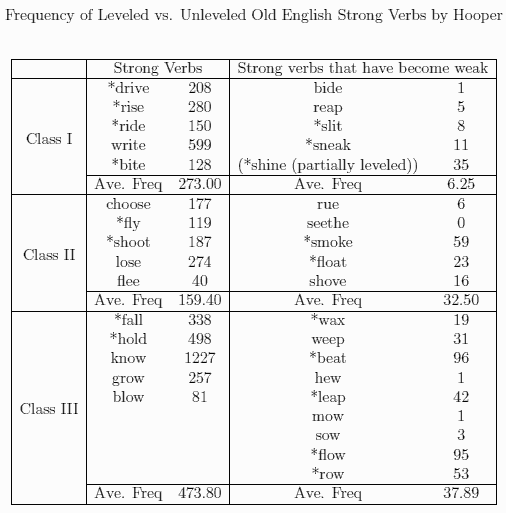英語に限らず言語において頻度の高い語は妙な振る舞いをする ([2009-09-20-1]) .現代英語では,動詞の過去・過去分詞,名詞の複数,形容詞・副詞の比較級・最上級で不規則な振る舞いをするものには,高頻度語が確かに多い.名詞の複数形に話を絞ると,借用語は別にして本来語で考えると men, children, feet, teeth などがすぐに思い浮かぶ.しかし,geese, mice, oxen, sheep などははたしてそれほど高頻度語といえるだろうか.[2010-03-01-1]で紹介した高頻度語リストから BNC lemma を眺めた限り,goose や ox などは上位6318語に入っていない.( oxen については[2010-08-22-1]を参照.)
しかし,geese や oxen もかつては現代よりも身近な動物であり,使用頻度も高かったと思われる.それが,身近でなくなってからも一種の惰性により不規則形を保持してきたものと考えられるだろう.もちろん,現代あるいは過去における高頻度だけを根拠に,不規則な現象を体系的に説明することはできない.しかし,頻度と規則性の関係が無視しえないことは確かである.関連する議論を McMahon (73) より引用する.
It has been suggested that residual words are often the most frequently occurring, which will be heard and learned earliest by the child and which are furthermore most susceptible to correction if the child does produce a regularised form like **foots. Some objections can be raised; for instance, ox is not a particularly common noun in modern English - although it probably occurred rather frequently in Middle English. Ox might have been expected to regularise as it became less common, but this decrease in frequency probably overlapped with the rise of literacy, which tends to slow down analogical change. In general, the connection of resistance to analogy with frequency seems to hold.
名詞複数形の研究をしていると,古い英語(特に中英語)のテキストに現われる動物名詞の羅列に敏感に反応してしまう.先日も Kyng Alisaunder を読んでいて,次のような文章に出くわした.マケドニア王が,Alisaunder と Philippe のうち荒馬 Bulcifal を操れる者を世継ぎとすることを決め,その競技の前に神に捧げ物をするという場面である.昨日の記事[2011-03-21-1]と同様,Smithers 版から B (MS. Laud Misc. 622 of the Bodleian Library, Oxford) と L (MS. 150 of the Library of Lincoln's Inn, London) の2バージョンを比較しながら引用する(動物複数名詞を赤字とした).
Oxen, sheep, and ek ken,
many on he dude slen,
And after he bad his goddes feyre
He most wyte of his eyre,
Of Alisaunder and Philippoun,
Who shulde haue þe regioun. (B 759--64)
Oxen schep and eke kuyn
Monyon he dude slen
And after he bad his godus faire
He moste y witen of his aire
Of Alisaundre or of Philipoun
Whiche schold haue þe regioun (L 756--61)
もう1つは,Alexander 軍が Darius 軍と戦うために準備をしている場面.
Hij charged many a selcouþe beeste
Of olifauntz, and ek camayles,
Wiþ armure and ek vitayles,
Longe cartes wiþ pauylounes,
Hors and oxen wiþ venisounes,
Assen and mulen wiþ her stouers; (B 1860--65)
Y chargid mony a selcouþ beste
Olifauns and eke camailes
Wiþ armure and eke vitailes
Long cartes wiþ pauelouns
Hors and oxen wiþ vensounes
Assen and muylyn wiþ heore stoueris (L 1854--59)
さらにもう1つ,Darius 軍の進軍の場面より.
Ycharged olifauntz and camaile,
Dromedarien, and ek oxen,
Mo þan ȝe connen asken. (B 3402--04)
And charged olifans and camailes
Dromedaries assen and oxen
Mo þan ȝe can askyn (L 3385--87)
このように動物名詞が列挙されると,中英語期にはこうした動物が(少なくとも物語の設定において)いかに身近であったかを確認できるとともに,当時の規則複数化の攻勢と不規則複数保持の守勢を具体的に把握することができる.
・ McMahon, April M. S. Understanding Language Change. Cambridge: CUP, 1994.
・ Smithers, G. V. ed. Kyng Alisaunder. 2 vols. EETS os 227 and 237. 1952--57.
[
|
固定リンク
|
印刷用ページ
]
